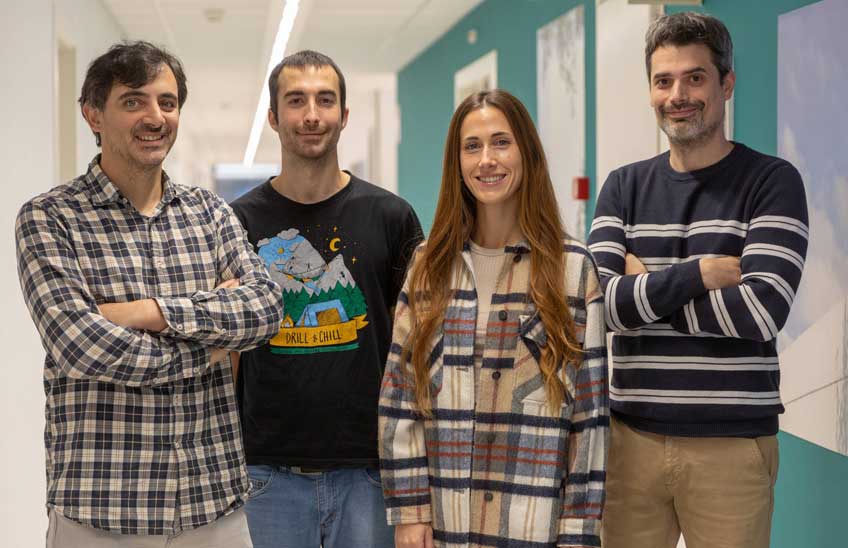Discovery of how the second most prevalent blood cancers form and evolve
Researchers from Cima University of Navarra and the University of Cambridge describe for the first time specific mechanisms of leukemia that prevent the development of healthy cells and favor its evolution.

FotoManuel Castells<br>/De izquierda a derecha: David Lara y Julen Mendieta, junto a otros investigadores del Cima que participan en el estudio. Ainhoa Goñi está ausente en la foto.
31 | 10 | 2023
An international team of researchers from the Cima University of Navarra and the University of Cambridge describe for the first time the regulatory mechanisms Genetics that favor the evolution of leukemia. In this study, the most comprehensive to date, they have analyzed the differences that exist in the generation of healthy blood cells versus leukemic blood cells. Specifically, they have focused on characterizing the gene regulation mechanisms that cells use to decide when and to what extent a gene is activated or deactivated (gene expression). Studying this process is very important because gene regulation determines whether the identity that the cells will take on is that of a healthy cell or a leukemic cell.
Using state-of-the-art technologies, researchers have revealed that leukemic cells corrupt core topic gene regulatory mechanisms that determine the identity of healthy cells, which blocks their evolution into mature healthy cells and facilitates tumor growth.
Leukemia is the second most prevalent blood cancer. According to the latest report of the network Spanish Cancer Registry on the estimates of this disease in our country, in 2023 Spain will have 6,411 new cases of people diagnosed with leukemia. This finding opens the door to the development of new treatments for these cancer patients.
The results of this multicenter study are published in the latest issue of the prestigious scientific journal Nature Genetics. Researchers from the University of Salzburg (Austria) and the biotech company Relation Therapeutics (UK) have also collaborated in this work . Several of its researchers belong to research center Biomedica en network en Cáncer (CIBERONC) and to the Institute of research Sanitaria de Navarra (IdiSNA). This project has been funded by the "la Caixa" Banking Foundation, the European Commission (Marie Skłodowska-Curie Actions) and the Cancer Research UK, Wellcome Trust, among other institutions.
To get into the origin of the training cellular
The process of training of blood cells (hematopoiesis) begins in the hematopoietic stem cells, which are capable of generating the different types of blood cells (white blood cells, red blood cells and platelets). Specifically, it is in the chromatin (the mixture of DNA and proteins that form the chromosomes) that the regulatory processes occur Genetics that give rise to the great variety of cell types present in the blood. Two groups of proteins called chromatin factors and transcription factors are involved in these processes.
Transcription factors mark the specific genes to be activated in each cell subject and chromatin factors regulate the expression of these genes by changes in the structure Biochemistry of chromatin. In this way, the identity of blood cells is determined. Dysregulation of these processes triggers various blood cancers, leukemia being the second most frequent.
Until now, the role of chromatin factors in determining cell identity was unclear. However, the team of researchers from Cima and Cambridge have demonstrated that chromatin factors are a crucial element in the regulation of cell identity. To do this, they have used state-of-the-art CRISPR and single-cell technologies. "Thanks to the use of a technology that allows the study of individual cells, we have demonstrated the complexity of the processes that regulate cells, revealing a great diversity in the function of chromatin factors, as well as other functions shared with transcription factors," explain Julen Mendieta and Ainhoa Goñi, first authors of the study and researchers of the Hemato-Oncology Program at Cima, integrated in the Cancer Center Clínica Universidad de Navarra.
Cellular corruption in leukemia
By studying the processes that regulate cell identity in leukemia, this international team has revealed how leukemic cells corrupt the normal functions of chromatin factors to block evolution toward healthy cell types and facilitate tumor growth. In their analysis, they observed that new transcription factor and chromatin factor complexes unique to leukemic cells were formed in this alteration. "As these complexes are specific to leukemia and are not required for normal hematopoiesis, they are an ideal target for a therapy that can deactivate them without causing any further harm to the patient, unlike current treatments such as chemotherapy, which have high levels of toxicity," says David Lara Astiaso, researcher of department of Hematology at the University of Cambridge and senior author of the study.
Professor Brian Huntly, director of department of Hematology at the University of Cambridge and co-leader of the study, emphasizes that "identifying a potential new therapeutic pathway for leukemia is particularly important. For example, in acute myeloid leukemia, which is the most common in adults and very aggressive, only 15% of people diagnosed with this disease survive more than five years."
reference letter bibliographic
→ Lara-Astiaso, David et al. "In vivo screening characterizes chromatin factor functions during normal and malignant hematopoiesis." Nature genetics vol. 55,9 (2023): 1542-1554. doi:10.1038/s41588-023-01471-2
